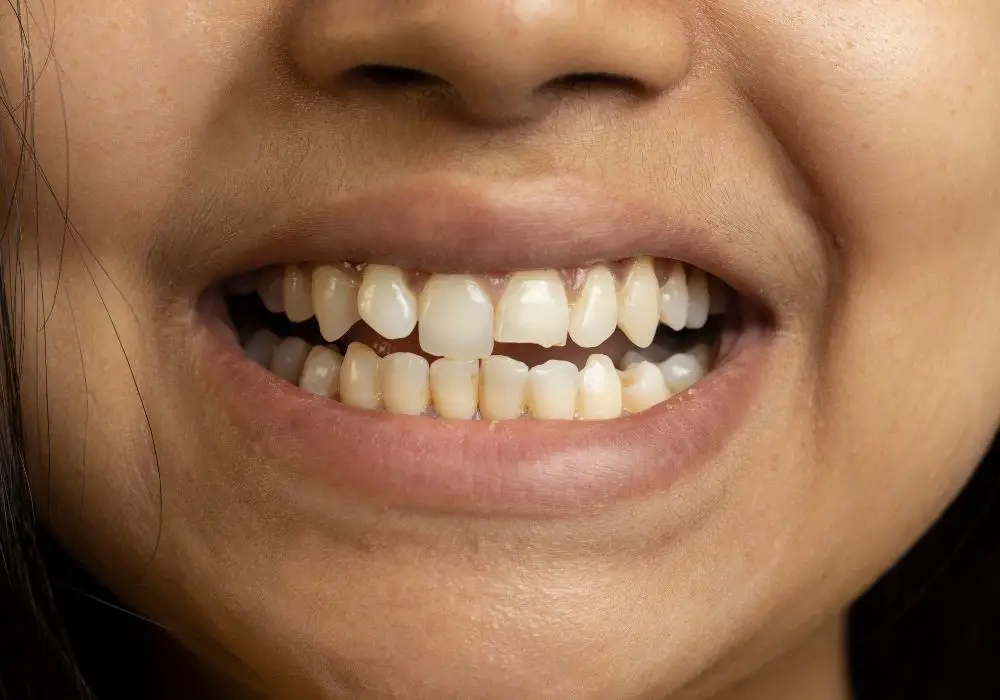Having damaged teeth can negatively impact your oral health, appearance, and self-confidence. Thankfully, with today’s advanced dental treatments, dentists have many options for restoring damaged teeth. In most cases, dentists can repair chipped, cracked, broken, or otherwise damaged teeth and help patients regain their beautiful, healthy smiles.
What causes tooth damage?
There are several potential causes of tooth damage, including:
1. Trauma and injury
Sports injuries, falls, automobile accidents, and other impacts can chip, crack, or break teeth. Facial and mouth trauma from events like bike accidents, playground injuries, sports collisions, or physical violence often results in dental damage. Teeth can fracture or break off at the gum line from high-force blunt trauma.
2. Tooth decay
Untreated tooth decay weakens tooth structure over time, making teeth more prone to damage. Cavities form through acid erosion of the enamel and dentin layers. As decay spreads to the inner pulp layer, it can reach the point of cavitation, infection, and resulting tooth fractures.
3. Grinding and clenching
Habits like bruxism (teeth grinding) and clenching can wear down tooth enamel over time, leading to chips, fractures, and other damage. Forceful grinding or tapping of the teeth can stress the enamel to the point of cracking.
4. Age and wear
As we age, teeth can become more brittle and prone to cracking and chipping from normal chewing and biting forces. Older dental work like fillings can also weaken and deteriorate over decades of use, making teeth more vulnerable to breakage.
5. Eating disorders
Those suffering from eating disorders like anorexia or bulimia often experience vomit-related acid erosion and damage to tooth enamel. The resulting thinning leaves teeth more susceptible to cracking.
6. Malocclusion
An improper bite alignment can lead to uneven forces on the teeth that cause fractures and chips over time. Orthodontic treatment may be needed to correct a problematic bite.
Common types of tooth damage

1. Chips and cracks
Chips range from minor enamel loss to more extensive damage involving dentin and pulp. Small chips may result in tooth sensitivity or rough areas but no major problems. More severe chips can lead to pain, infection, and tooth death if pulp is exposed. Cracks can range from small hairline fractures to large splits extending below the gumline. Depending on severity and location, cracks may require a root canal or extraction.
2. Broken and fractured teeth
Teeth can partially or fully break due to trauma. Fractures often involve the root structure beneath the gumline. Vertical root fractures are very severe, often requiring extraction. Other breaks may be repaired with root canals and crowns if enough healthy tooth remains.
3. Worn-down teeth
Over time, acid, abrasion, and grinding can wear down and shorten the teeth. This is known as tooth attrition. It leads to a flattened, rounded appearance and increased tooth sensitivity or decay risk. Excessive wear can harm the teeth and bite function.
4. Decayed teeth
Untreated tooth decay weakens the tooth structure, eventually leading to cavitation, infection, and tooth fractures. Left unaddressed, caries can progress through enamel and dentin until reaching the pulp, resulting in severe infection, pain, and tooth loss.
Can chipped and cracked teeth heal on their own?

Minor chips and hairline cracks located only in the outer enamel layer may not require immediate treatment. However, it’s important to keep a close eye on any cracks, as they can deepen over time and allow bacteria to enter the tooth.
More extensive damage involving dentin, pulp, or the root should be treated promptly to prevent further deterioration. Leaving cracks untreated can lead to infection, abscesses, and tooth loss. It’s best to have a dentist evaluate any chips or cracks to determine the severity and recommend appropriate treatment.
Dental procedures to repair damaged teeth

Today’s dentists have a wide range of advanced procedures to restore even severely damaged teeth. Common treatments include:
1. Dental bonding
Composite resin material is applied to repair chips, cracks, and decay. The material matches the color of your natural teeth. Dental bonding is an affordable, non-invasive option suitable for minor damage.
2. Dental crowns
Damaged teeth are capped with custom-fit ceramic or porcelain crowns to restore shape, appearance, and function. Crowns provide full encasement following root canals or for extensive damage. However, the tooth must be shaved down for crown placement.
3. Root canals
If tooth cracks extend into the pulp, a root canal treatment may be needed to remove infected pulp and save the tooth. The remaining tooth structure can then be protected with a crown.
4. Dental implants
Implants anchored in the jawbone can replace teeth that cannot be saved with other treatments. Implants look, feel, and function like natural teeth. They preserve bone and stimulate the jawsite.
5. Dental bridges
Bridges span the space where teeth are missing to restore your smile. They are anchored to adjacent natural teeth or implants. Traditional bridges require shaving down the anchor teeth.
6. Dental veneers
Thin porcelain covers placed over the front of damaged teeth can improve cosmetic appearance. Veneers provide an aesthetic solution for minor chips, cracks, and discoloration without shaving the tooth.
7. Tooth splinting
Splinting stabilizes loose, mobile, or fragile teeth by connecting them together. This can provide stabilization for cracked teeth while healing occurs.
8. Orthodontic treatment
Correcting a poor bite alignment may be necessary to prevent further damage to fractured or chipped teeth. Orthodontic intervention can remove harmful biting forces.
What to expect when getting a damaged tooth repaired?

Fixing a damaged tooth is usually a quick and comfortable process. Here’s what you can generally expect:
- Examination – Your dentist will perform a thorough clinical and radiographic examination, checking for signs of infection, pulp damage, root fractures, etc. They will then determine the best repair option for your situation.
- Numbing – The tooth and surrounding gum tissue will be numbed with a local anesthetic before treatment begins. This provides a pain-free experience.
- Tooth preparation – For treatments like crowns, veneers or bridges, some natural tooth structure may need to be conservatively reduced to accommodate the dental work.
- Impressions – Molds or images of the prepared tooth may be taken to fabricate the repair in a dental laboratory. Temporary restorations protect the tooth in the meantime.
- Placement – At the follow-up visit, the dentist meticulously shapes, colors, and fits the permanent restorative material like a crown. Adjustments are made until the restoration looks and feels natural.
- Bonding – Dental adhesives are applied to firmly anchor the restoration to the prepared tooth structure. Special curing lights quickly harden the material.
- Finishing – Finally, the dentist fine-tunes the shape, fit, and bite of the repaired tooth before polishing it to a natural smoothness and luster. Numbing medication wears off shortly after.
Aftercare for repaired teeth

To get the most longevity from repaired teeth, be sure to follow your dentist’s at-home care instructions. Typical recommendations include:
- Brushing twice a day with a soft-bristle or powered toothbrush and fluoride toothpaste to protect repairs
- Flossing once daily, taking care around restorations
- Rinsing daily with an antiseptic mouthwash to maintain oral health
- Avoiding very hard, crunchy, and sticky foods that could damage repairs
- Wearing a custom night guard if you grind your teeth to prevent cracking
- Seeing your dentist for regular exams and professional cleanings every 6 months
With proper oral hygiene and regular dental check-ups, you can maximize the lifespan of repaired teeth. Alert your dentist promptly if you ever notice new cracks, chips, loosening, or damage to restorations. Avoid habits like chewing ice, pens, nails, and other hard objects.
The benefits of repairing damaged teeth

Getting damaged teeth professionally repaired offers many benefits for your health, appearance, and quality of life, including:
- Prevents worsening damage – Fixing chips, cracks, and decay helps stop further deterioration that could require extraction.
- Saves natural tooth structure – Where possible, dental procedures conserve healthy tooth structure.
- Maintains chewing function – Restoring damaged teeth allows comfortable biting and chewing ability.
- Relieves pain – Repairs eliminate painful tooth sensitivity and infection in decayed teeth.
- Avoids tooth loss – By saving damaged teeth, implants and bridges may not be necessary.
- Stops decay – Fillings and sealants prevent caries progression and protect tooth roots.
- Improves smile aesthetics – Repairs restore a beautiful, natural-looking smile you can show with confidence.
- Allows dental implant integration- Stabilizing damaged teeth adjacent to implant sites helps ensure implant success.
- Enables eating enjoyment – Allows you to comfortably eat all your favorite foods again.
- Protects long-term health – Preventing tooth loss helps maintain nutrition, oral function, and well-being.
- Saves money – Repairs cost significantly less than implants and bridges over the long run.
Don’t live with damaged teeth and chips that can worsen over time. See your dentist right away for an evaluation and advanced restoration solutions. With today’s treatments, repairing damage and rebuilding smiles is easier than ever.
FAQ about repairing damaged teeth
Can dentists repair teeth that are broken below the gumline?
In many cases, yes. Using advanced techniques like root canals, crown lengthening surgery, and dental crown restorations, dentists can often save teeth broken below the gumline. The prognosis depends on the severity and level of fracture, but teeth broken under the gums can frequently be restored.
How long do repaired teeth last?
With proper oral care, repaired teeth can last many years, often over a decade. Composite fillings and bondings may need replacement every 5-10 years. Porcelain crowns, veneers, and bridges tend to last 10-15 years or longer before replacement is recommended. Good hygiene and regular dental care maximizes longevity.
Do repairs like dental crowns require any special care?
Crowns and other restorations require the same daily brushing and flossing as your natural teeth. While usually durable, avoid biting or chewing extremely hard foods which could crack or dislodge repairs. See your dentist regularly for exams to ensure restorations remain sealed and damage-free. Report any new cracks or loosening immediately.
Can chipped front teeth be fixed for a nicer smile?
Absolutely. Small chips on front teeth can often be repaired with tooth-colored composite bonding or no-prep porcelain veneers that restore a flawless smile. Even significantly damaged, discolored, or crooked front teeth can usually be greatly improved with modern veneers or crowns for an ideal aesthetic outcome.
Do repairs strengthen damaged teeth?
Dental restorations not only repair damage, but reinforce and strengthen weakened tooth structure. Carefully fitted crowns fully envelop the tooth for protection and stabilization. Root canals remove inner infection allowing safer restoration. Veneers add a protective shield to the outer enamel. Well-designed repairs prevent further cracking and damage.
Should I repair teeth with minor cracks and chips?
Yes, it’s wise to promptly repair even minor tooth cracks before they can worsen. Small fractures that don’t currently hurt may expand over time, leading to pain and infection. Restorations like dental bonding can stabilize cracks in the enamel to prevent propagation. It’s smart to stabilize cracks now rather than wait for bigger problems.
Conclusion
Damaged teeth do not have to mean a smile you want to hide or dental health problems. Today’s cutting-edge treatments make it possible to fully restore chips, cracks, decay, wear, and trauma in ways that are natural-looking, functional and long-lasting. Seeking prompt professional repair of any tooth damage can help you regain and maintain excellent dental health and an attractive smile. With the amazing solutions available from your dentist, even severe tooth damage can be repaired and your smile renewed.






